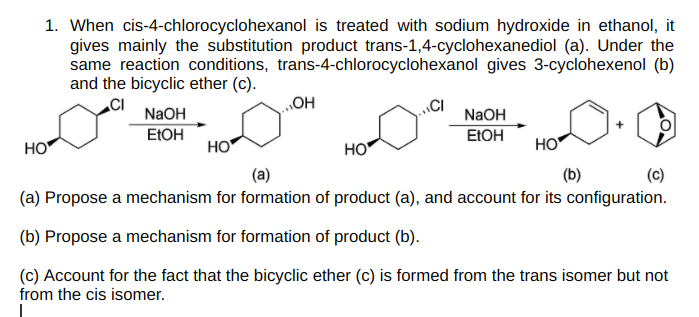1. When cis-4-chlorocyclohexanol is treated with sodium hydroxide in ethanol, it gives mainly the substitution product trans-1,4-cyclohexanediol (a). Under the same reaction conditions, trans-4-chlorocyclohexanol gives 3-cyclohexenol (b) and the bicyclic ether (c). NaOH ELOH HO HO" NaOH EIOH HO HO HO (a) (b) (c) (a) Propose a mechanism for formation of product (a), and account for its configuration. (b) Propose a mechanism for formation of product (b). (c) Account for the fact that the bicyclic ether (c) is formed from the trans isomer but not from the cis isomer.
1. When cis-4-chlorocyclohexanol is treated with sodium hydroxide in ethanol, it gives mainly the substitution product trans-1,4-cyclohexanediol (a). Under the same reaction conditions, trans-4-chlorocyclohexanol gives 3-cyclohexenol (b) and the bicyclic ether (c). NaOH ELOH HO HO" NaOH EIOH HO HO HO (a) (b) (c) (a) Propose a mechanism for formation of product (a), and account for its configuration. (b) Propose a mechanism for formation of product (b). (c) Account for the fact that the bicyclic ether (c) is formed from the trans isomer but not from the cis isomer.
Organic Chemistry
8th Edition
ISBN:9781305580350
Author:William H. Brown, Brent L. Iverson, Eric Anslyn, Christopher S. Foote
Publisher:William H. Brown, Brent L. Iverson, Eric Anslyn, Christopher S. Foote
Chapter9: Nucleophilic Substitution And Β-elimination
Section: Chapter Questions
Problem 9.39P: Following are diastereomers (A) and (B) of 3-bromo-3,4-dimethylhexane. On treatment with sodium...
Related questions
Question
100%
Can you please help me with the attached question? Thank you.

Transcribed Image Text:1. When cis-4-chlorocyclohexanol is treated with sodium hydroxide in ethanol, it
gives mainly the substitution product trans-1,4-cyclohexanediol (a). Under the
same reaction conditions, trans-4-chlorocyclohexanol gives 3-cyclohexenol (b)
and the bicyclic ether (c).
OH
CI
NaOH
ELOH
NaOH
EIOH
HO
HO
HO
HO
(a)
(b)
(c)
(a) Propose a mechanism for formation of product (a), and account for its configuration.
(b) Propose a mechanism for formation of product (b).
(c) Account for the fact that the bicyclic ether (c) is formed from the trans isomer but not
from the cis isomer.
Expert Solution
This question has been solved!
Explore an expertly crafted, step-by-step solution for a thorough understanding of key concepts.
This is a popular solution!
Trending now
This is a popular solution!
Step by step
Solved in 3 steps with 3 images

Knowledge Booster
Learn more about
Need a deep-dive on the concept behind this application? Look no further. Learn more about this topic, chemistry and related others by exploring similar questions and additional content below.Recommended textbooks for you

Organic Chemistry
Chemistry
ISBN:
9781305580350
Author:
William H. Brown, Brent L. Iverson, Eric Anslyn, Christopher S. Foote
Publisher:
Cengage Learning


Organic Chemistry
Chemistry
ISBN:
9781305580350
Author:
William H. Brown, Brent L. Iverson, Eric Anslyn, Christopher S. Foote
Publisher:
Cengage Learning
